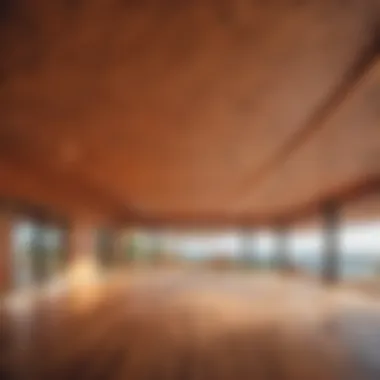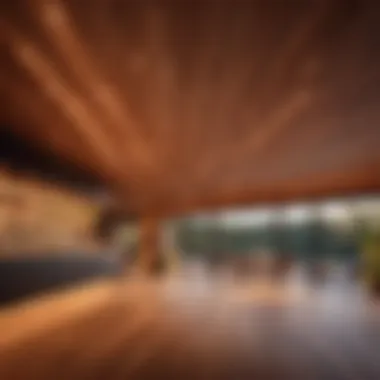Materials:
- High-quality wood planks: 10 feet x 6 inches x 1 inch
- Deck screws: 2.5 inches
- Wood stain or sealant: 1 gallon
- Paintbrush or roller
- Measuring tape
- Level
- Drill with screwdriver bit
- Saw
- Safety goggles
- Dust mask
- Work gloves
DIY Steps:
- Start by measuring the dimensions of your deck space to determine the quantity of wood planks required.
- Purchase high-quality wood planks of the specified measurements to ensure durability and longevity.
- Prepare the deck surface by cleaning it thoroughly and ensuring it is dry before proceeding.
- Lay out the wood planks in the desired pattern to visualize the final look before installation.
Technical Aspects:
- The installation process typically takes 1-2 days, depending on the size of the deck ceiling.
- Use a level regularly to ensure the planks are aligned correctly for a professional finish.
- Applying wood stain or sealant can enhance the appearance and protect the wood from outdoor elements.
- Utilize safety gear such as goggles, dust masks, and gloves to prioritize your well-being during the project.
DIY Project Process:


- Begin by attaching the first wood plank at the edge of the deck using deck screws and a drill.
- Continue by securing each subsequent plank parallel to the previous one, maintaining uniform spacing throughout.
- Use a saw to trim the last plank to fit snugly at the opposite edge of the deck ceiling.
- Apply a coat of wood stain or sealant using a paintbrush or roller to protect the surface and enhance aesthetics.
Troubleshooting Tips:


- If the wood planks warp or bow, adjust the screws to release pressure and allow for natural expansion.
- In case of uneven spacing, carefully remove and readjust the planks for a uniform appearance.
- If the wood cracks during installation, consider pre-drilling holes to prevent splitting and ensure a secure attachment.
- Regularly inspect the deck ceiling for signs of wear and apply maintenance as needed to prolong its lifespan.
Understanding Wooden Deck Ceilings


Wooden deck ceilings are a crucial aspect of outdoor living spaces, providing both structural support and aesthetic appeal. In this article, we delve deep into the realm of wooden deck ceilings to unveil their intricate details and significance. From the specific types of wood used to the benefits they offer, understanding wooden deck ceilings is key to creating a functional and visually pleasing outdoor environment.
Definition and Purpose
Structural Definition
Structural definition refers to the framework and composition of wooden deck ceilings, which serve as the overhead structure for outdoor deck spaces. The structural integrity of wooden deck ceilings is paramount in ensuring the safety and durability of the entire deck. Common materials used for structural definition include pressure-treated lumber or composite wood materials. These choices offer both strength and resilience to withstand outdoor elements, making them popular in deck construction. However, it is vital to consider potential maintenance requirements and environmental impacts when opting for specific structural definitions in wooden deck ceilings.
Functional Significance
The functional significance of wooden deck ceilings lies in their ability to provide shelter, shade, and added ambiance to outdoor living areas. By covering the upper part of the deck, wooden ceilings contribute to creating a cozy and intimate setting for various outdoor activities. Additionally, they offer protection from the sun, rain, and other natural elements, enhancing the overall comfort of the space. The unique feature of functional significance is their versatility in design, allowing homeowners to customize their deck ceilings to suit specific aesthetic preferences and functional needs. However, maintenance and periodic inspections are essential to preserve the functional efficiency of wooden deck ceilings over time.
Types of Wood Used
Hardwood Varieties
Hardwood varieties are prized for their durability and natural beauty, making them ideal choices for wooden deck ceilings. Hardwoods like teak, mahogany, and cedar are known for their resistance to decay and insect damage, ensuring longevity in outdoor applications. The key characteristic of hardwood varieties is their rich colors and distinct grain patterns, which add a touch of sophistication to deck ceilings. However, the high cost and maintenance requirements of hardwoods should be considered when selecting them for wooden deck ceilings.
Softwood Varieties
Softwood varieties, such as pine and fir, are popular options for wooden deck ceilings due to their affordability and ease of availability. While softer than hardwoods, softwood varieties offer versatility in design and finishing options, making them suitable for various aesthetic preferences. The unique feature of softwood varieties is their lighter weight and ease of installation, making them an attractive choice for DIY deck projects. However, softwoods may require more frequent maintenance and protective treatments to ensure longevity and durability in outdoor environments.
Benefits of Wooden Deck Ceilings
Natural Aesthetic Appeal
The natural aesthetic appeal of wooden deck ceilings adds warmth and charm to outdoor living spaces, creating a connection to nature in residential settings. Wood's organic texture and color variations infuse a sense of coziness and timelessness that complements different architectural styles. The key characteristic of natural aesthetic appeal is its ability to blend harmoniously with outdoor surroundings, whether in rustic, contemporary, or traditional settings. However, regular maintenance, such as staining or sealing, is essential to preserve the natural beauty of wooden deck ceilings and prevent weathering or discoloration.
Insulation Properties
Wooden deck ceilings offer excellent insulation properties, helping regulate indoor temperatures and reduce energy costs in residential properties. The thermal mass of wood enhances heat retention in colder seasons while promoting air circulation for cooling during warmer months. This natural insulation ensures a comfortable environment on the deck, extending the usability of outdoor living spaces throughout the year. The unique feature of insulation properties is their sustainability and eco-friendliness, providing a renewable and energy-efficient solution for homeowners. However, proper installation and ventilation strategies are critical to maximizing the insulation benefits of wooden deck ceilings and ensuring optimal performance over time.
Design Considerations
Design considerations play a pivotal role in the realm of wooden deck ceilings, shaping not only the aesthetics but also the functionality of the structure. When contemplating the design of wooden deck ceilings, several essential elements must be taken into account to ensure the optimal outcome. From structural integrity to visual appeal, each aspect significantly influences the overall efficacy of the wooden deck ceiling. By focusing on specific elements such as load-bearing capacity, moisture resistance, finishing options, color schemes, integration with surroundings, and more, homeowners can tailor their wooden deck ceilings to meet both practical needs and aesthetic preferences.
Structural Integrity
Load-Bearing Capacity
Load-bearing capacity is a crucial aspect of structural integrity in wooden deck ceilings. It refers to the maximum weight that the ceiling can support without compromising its stability. The load-bearing capacity directly impacts the safety and longevity of the deck ceiling, making it imperative to select materials and designs that can withstand the intended use. By choosing sturdy hardwood varieties or reinforced structures, homeowners can ensure that their wooden deck ceilings maintain structural integrity over time. While load-bearing capacity provides durability and reliability, it is essential to strike a balance between strength and aesthetics to achieve a harmonious design.
Moisture Resistance
Moisture resistance is another fundamental consideration in the design of wooden deck ceilings, particularly for outdoor structures exposed to natural elements. Moisture can lead to rot, decay, and mold growth, compromising the structural integrity and appearance of the ceiling. Incorporating moisture-resistant materials and protective coatings can help mitigate water damage and prolong the lifespan of the wooden deck ceiling. By prioritizing moisture resistance in the design process, homeowners can ensure that their deck ceilings remain resilient and visually appealing under varying weather conditions.
Aesthetic Elements
Finishing Options
The choice of finishing options significantly contributes to the overall look and feel of wooden deck ceilings. From natural wood finishes to painted surfaces, selecting the right finish can enhance the texture, color, and durability of the ceiling. Different finishing options offer unique benefits, such as UV protection, water repellency, and ease of maintenance. Homeowners can customize their deck ceilings with a variety of finishes to achieve the desired aesthetic effect, whether rustic and weathered or sleek and modern.
Color Schemes
Color schemes play a vital role in defining the visual appeal of wooden deck ceilings. By carefully selecting complementary or contrasting colors, homeowners can create a harmonious outdoor space that reflects their personal style. The choice of color can also affect the perceived size and atmosphere of the deck area, making it a key design consideration. Whether opting for natural wood tones, bold hues, or subtle shades, incorporating a thoughtfully coordinated color scheme can elevate the overall design of the wooden deck ceiling.
Integration with Surroundings
Outdoor Lighting
Outdoor lighting serves both functional and aesthetic purposes in the integration of wooden deck ceilings with their surroundings. Properly placed lights illuminate the deck area, enhancing safety and ambiance during evening gatherings. LED fixtures, solar-powered lamps, or string lights can all add character and warmth to the outdoor space, making it inviting and practical for extended use.
Greenery Incorporation
Integrating greenery into the design of wooden deck ceilings infuses natural beauty and vitality into the outdoor setting. From potted plants and hanging vines to vertical gardens, incorporating green elements softens the harsh lines of the structure and creates a seamless connection with nature. Greenery not only enhances the visual appeal of the deck area but also contributes to a healthier environment by promoting air quality and biodiversity. By carefully selecting plants that thrive in outdoor conditions, homeowners can enjoy a verdant retreat right at their doorstep.
Maintenance Practices
In the realm of wooden deck ceilings, the maintenance practices play a pivotal role in preserving the integrity and longevity of these structural elements. Regular upkeep ensures that the wooden deck ceilings not only retain their visual appeal but also continue to function effectively over time. Maintenance practices encompass various aspects, including regular inspections, cleaning techniques, and repair and restoration procedures.
Regular Inspections
Regular inspections are indispensable when it comes to maintaining wooden deck ceilings. Not only do they help in identifying potential issues at an early stage, but they also contribute to the overall durability of the structure. Two critical aspects of regular inspections include checking for rot and addressing pest infestations.
Checking for Rot
When it comes to wooden materials exposed to outdoor conditions, the risk of rot is a prevalent concern. Checking for rot involves closely examining the wooden boards for any signs of decay or deterioration. This process is crucial as it helps property owners identify and address areas that may require immediate attention. Additionally, addressing rot in its early stages can prevent further damage and ultimately prolong the lifespan of the wooden deck ceilings.
Addressing Pest Infestations
Pest infestations pose a significant threat to wooden deck ceilings, as insects and pests can gradually weaken the structure if not dealt with promptly. Addressing pest infestations involves not only identifying the presence of pests but also implementing effective measures to eradicate them. By addressing pest infestations proactively, homeowners can protect their wooden deck ceilings from potential damage and ensure their long-term functionality.
Cleaning Techniques
Maintaining clean wooden deck ceilings is essential not only for aesthetic reasons but also for structural durability. Two key cleaning techniques include removing debris and applying protective treatments.
Removing Debris
Regularly removing debris such as fallen leaves, dirt, and other detritus helps prevent moisture buildup and preserves the integrity of the wooden boards. This simple yet effective cleaning technique ensures that the wooden deck ceilings remain free from potential hazards that could compromise their structural stability.
Applying Protective Treatments
Applying protective treatments such as wood sealants or stains can significantly enhance the longevity of wooden deck ceilings. These treatments offer an additional layer of protection against environmental elements, including sunlight, moisture, and temperature fluctuations. By applying protective treatments, homeowners can safeguard their wooden deck ceilings and maintain their visual appeal for years to come.
Repair and Restoration
Despite regular maintenance, wooden deck ceilings may require occasional repair and restoration to address wear and tear over time. Two fundamental aspects of repair and restoration include replacing damaged boards and refinishing procedures.
Replacing Damaged Boards
When wooden boards show signs of damage or decay, replacing them becomes essential to maintain the structural integrity of the deck ceilings. This process involves carefully assessing the extent of the damage and installing new boards to ensure a seamless and sturdy surface. By promptly replacing damaged boards, homeowners can prevent further deterioration and extend the lifespan of their wooden deck ceilings.
Refinishing Procedures
Refinishing procedures involve sanding, staining, or painting the wooden surfaces to restore their original aesthetic appeal. This step not only enhances the visual appearance of the deck ceilings but also adds a layer of protection against external elements. Refinishing procedures not only breathe new life into wooden deck ceilings but also contribute to their overall longevity and durability. By incorporating these repair and restoration practices into the maintenance routine, homeowners can enjoy the beauty and functionality of their wooden deck ceilings for years to come.
Environmental Impact
Wooden deck ceilings are not only aesthetically pleasing but also hold significant environmental implications in their production and maintenance. Understanding the environmental impact of utilizing wood in construction is crucial in today's eco-conscious world. This section delves into the sustainable practices associated with wooden deck ceilings, highlighting key elements that contribute to reducing negative environmental effects.
Sustainability Practices
Certified Wood Sourcing
Certified wood sourcing plays a pivotal role in promoting sustainable forestry practices. By opting for certified wood, housewives and homeowners can ensure that the wood used in their deck ceilings comes from responsibly managed forests. This aspect aligns with the overarching goal of minimizing deforestation and encouraging tree replenishment. The certification guarantees that stringent environmental standards are met throughout the wood sourcing process, promoting biodiversity conservation and the protection of ecosystems. Utilizing certified wood sourcing not only supports the sustainability agenda but also provides assurance of ethical and environmentally friendly construction practices.
Recycling Initiatives
Embracing recycling initiatives within the realm of wooden deck ceilings represents a proactive approach towards environmental stewardship. Recycling wood offers a second life to timber products, reducing the demand for freshly harvested wood and alleviating pressure on natural forests. By incorporating recycled wood materials into deck ceiling construction, individuals contribute to waste reduction and energy conservation. The unique feature of recycling initiatives lies in their ability to transform discarded wood into valuable resources, limiting environmental degradation and advancing the circular economy model. While challenges such as material purity and sourcing complexities may arise, the benefits of recycling initiatives far outweigh these hurdles, making them a favorable choice for sustainable construction practices.
Carbon Footprint Analysis
Wooden deck ceilings' carbon footprint analysis scrutinizes the environmental impact of wood utilization, emphasizing the significance of making informed choices to mitigate carbon emissions. This section explores key aspects such as comparative studies and mitigation strategies aimed at reducing the overall carbon footprint associated with wooden deck ceilings.
Comparative Studies
Engaging in comparative studies allows for an in-depth evaluation of the environmental performance of wood compared to alternative construction materials. By assessing factors like production energy, transportation emissions, and end-of-life disposal, comparative studies provide valuable insights into the ecological footprint of wooden deck ceilings. These studies enable informed decision-making by highlighting the environmental advantages of wood over synthetic counterparts, showcasing its renewable and low-impact characteristics. Leveraging comparative studies empowers individuals to make environmentally responsible choices when selecting materials for deck ceiling construction.
Mitigation Strategies
Implementing mitigation strategies is imperative in addressing and offsetting the carbon footprint associated with wooden deck ceilings. These strategies encompass a range of approaches, from incorporating carbon sequestration techniques in forestry management to adopting energy-efficient construction practices. By focusing on reducing emissions and enhancing carbon storage, mitigation strategies strive to balance the environmental impact of wood utilization. Embracing innovative technologies and sustainable practices within the construction sector contributes to mitigating climate change and fostering a more eco-friendly built environment. While certain challenges such as cost implications and implementation complexities may exist, the benefits of mitigation strategies far outweigh the drawbacks, positioning them as essential components of sustainable construction efforts.
This detailed exploration of sustainability practices and carbon footprint analysis in relation to wooden deck ceilings underscores the paramount importance of environmental stewardship in construction activities. By delving into these intricacies, housewives and homeowners gain valuable insights into promoting eco-friendly practices within their residential spaces, fostering a harmonious coexistence with the natural environment.





